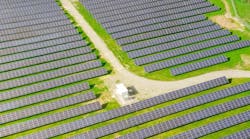This month, the International Energy Agency (IEA) released its latest Renewable Energy Market Update, which provides both a look back at 2021 and an outlook for 2022-2023. Last year saw record-breaking capacity added for renewable electricity around the globe, IEA says. This, in spite of the pandemic, persistent supply chain disruptions, and inflation.
The 6% global increase, to just under 295 GW, was due primarily to increases in solar PV and hydroelectric production, since wind capacity logged a significant 17% decrease, according to the report.
Specifically, China claimed 46% share of the global capacity additions, although its onshore wind and utility-scale PV both declined from record 2020 levels. The EU nations followed China in increased capacity, breaking their all-time record set in 2011, thanks to significant growth in Spain, France, Poland, and Germany resulting from government-run auctions and other incentives.
In the U.S., the reduction in the production tax credit (PTC) resulted in a 25% decline in onshore wind capacity additions, although the continuing investment tax credits (ITC) drove solar PV expansion. The IEA report suggests that solar PV growth in the U.S. would be faster if not hindered by supply chain issues. (Also, the U.S. Dept. of Commerce's investigation into Southeast Asian solar panel manufacturers has delayed billions of dollars’ worth of new solar projects in the U.S.)
Even before the pandemic disruptions, the U.S. was relying on foreign suppliers for solar panels, wind turbines, lithium-ion batteries, and the critical metals, such as lithium and cobalt, used in their manufacture. In 2020, only 3% of the world’s solar PV panels were manufactured in the U.S. China, alone, accounts for 63% of polysilicon, a key material in PV panels and 79% of the solar modules, themselves. Politics, of course, enters into this issue. The largest lithium deposit in the U.S. is situated on sacred Native American land. And environmental activists oppose mining due to the potential harm to local wildlife and worsening water shortages. So, although more mining of these materials would reduce the U.S. dependence on foreign suppliers, the potential environmental and community impacts so far have restricted it.
Looking ahead to this year and next, the IEA projects an 8% year-over-year increase in renewable capacity for 2022, to more than 300 GW, with solar PV accounting for 60% of the gain. Onshore wind installations are expected to see a slight increase, while offshore wind capacity will decline from last year. Higher costs for both PV and wind are expected to continue through 2023. Since oil, natural gas, and coal prices are also expected to remain high, the effect on renewable’s competitiveness should be negligible.
Russia’s invasion of Ukraine obviously impacted global energy, and many countries have moved to reduce or eliminate their dependence on Russian energy supplies. This will further encourage the development of clean energy technologies to reduce fossil fuel consumption.
A regular contributor to HPAC Engineering and a member of its editorial advisory board, the author is a principal at Sustainable Performance Solutions LLC, a south Florida-based engineering firm focusing on energy and sustainability. He can be reached at [email protected].









